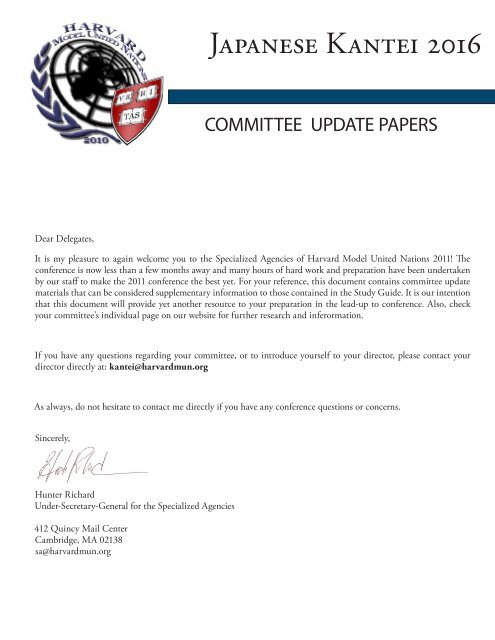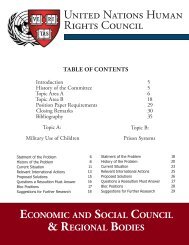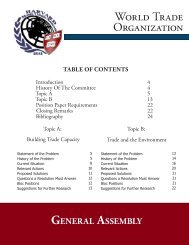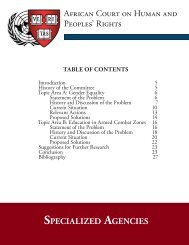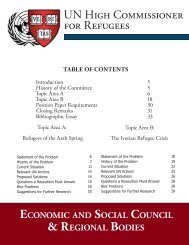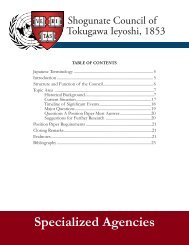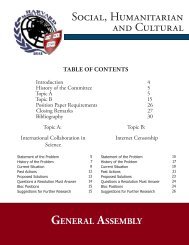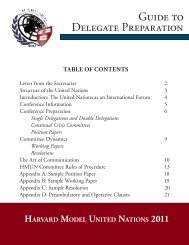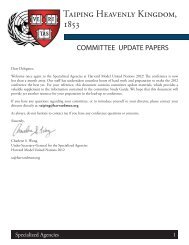Japanese Kantei 2016 - Harvard Model United Nations
Japanese Kantei 2016 - Harvard Model United Nations
Japanese Kantei 2016 - Harvard Model United Nations
Create successful ePaper yourself
Turn your PDF publications into a flip-book with our unique Google optimized e-Paper software.
<strong>Japanese</strong> <strong>Kantei</strong> <strong>2016</strong><br />
Committee Update Papers<br />
Dear Delegates,<br />
It is my pleasure to again welcome you to the Specialized Agencies of <strong>Harvard</strong> <strong>Model</strong> <strong>United</strong> <strong>Nations</strong> 2011! The<br />
conference is now less than a few months away and many hours of hard work and preparation have been undertaken<br />
by our staff to make the 2011 conference the best yet. For your reference, this document contains committee update<br />
materials that can be considered supplementary information to those contained in the Study Guide. It is our intention<br />
that this document will provide yet another resource to your preparation in the lead-up to conference. Also, check<br />
your committee’s individual page on our website for further research and inferormation.<br />
If you have any questions regarding your committee, or to introduce yourself to your director, please contact your<br />
director directly at: kantei@harvardmun.org<br />
As always, do not hesitate to contact me directly if you have any conference questions or concerns.<br />
Sincerely,<br />
Hunter Richard<br />
Under-Secretary-General for the Specialized Agencies<br />
412 Quincy Mail Center<br />
Cambridge, MA 02138<br />
sa@harvardmun.org
<strong>Japanese</strong> <strong>Kantei</strong>: <strong>2016</strong><br />
Committee Update<br />
Th e Ya k u z a: Ba c k g r o u n d<br />
The long and varied relationship the Yakuza has held<br />
with Japan may seem very strange to foreigners. The<br />
term “organized crime” brings to mind images of mafia<br />
godfathers, family-style organizations, and an underworld<br />
network of influence by which the gangs intimidate their<br />
way into money and power; all of these images apply to<br />
the Yakuza, but these gangsters operate in a fashion quite<br />
distinct among organized criminals. Their distinctive<br />
culture, supposedly based in a rigid moral code and<br />
traditional family values, combined with an interest in<br />
influencing politics and racketeering, has made them an<br />
intrinsic part of Japan, for better or worse. In these past<br />
few decades, however, the sureness of their continuing<br />
influence has been deeply shaken.<br />
Although it may be a little fanciful, modern-day<br />
Yakuza insist that their roots reach as far back as the<br />
17 th century, when packs of newly unemployed samurai<br />
(called “ronin”) began harassing small towns. Groups of<br />
townsfolk, known as “machi-yokko” organized to resist<br />
the onslaught; according to legend these were Robin<br />
Hood-like figures who protected the helpless, strictly<br />
adhering to the dual principles of “giri” and “ninjo” (two<br />
<strong>Japanese</strong> concepts that have no true English translation;<br />
the closest approximation is a sense of obligation or<br />
being tied by fate, and compassion, respectively.) These<br />
machi-yokko, honorable outlaws, came to be a cultural<br />
phenomenon, starring in innumerable legends and tall<br />
tales. Over time, however, the need for such vigilantes<br />
passed and Japan was left with disorderly bands of young<br />
men with a penchant for violence and the habit of being<br />
able to do as they please. As the anxious government<br />
began to crack down on such groups, their membership<br />
shifted towards a rougher demographic, namely the<br />
“burakumin” (Japan’s caste of ancestral outcasts, similar<br />
to Indian untouchables; it is estimated that up to 60%<br />
of modern Yakuza have burakumin ancestry.) In fact, the<br />
term “Yakuza” is actually a reference to the worst possible<br />
hand in a popular <strong>Japanese</strong> card game, indicating the<br />
unlucky lot of these burakumin. These newer gangs,<br />
deprived of their original function, turned to two main<br />
illicit sources of income, depending on their location. In<br />
the towns and cities, the “tekiya” sprang up – an umbrella<br />
term for any of the various street vendors of shoddy or<br />
illegal goods. Along the main highways, gangs of machiyokko<br />
known as “bakuto” established a monopoly on<br />
gambling dens. Both groups, tekiya and bakuto, still<br />
mainly comprise the modern concept of the Yakuza.<br />
The ideal Yakuza gang is a microcosm of <strong>Japanese</strong><br />
culture and values: its organization, traditions, and even<br />
political affiliations all reflect the rich history of <strong>Japanese</strong><br />
society as a whole. Following the traditional <strong>Japanese</strong><br />
family dynamics, Yakuza gangs are organized around<br />
father-son, or oyabun-kobun, relationships, with one<br />
oyabun having many kobun, similar to the godfather and<br />
family typical of American mafia. This creates a pyramidal<br />
structure that may include sub-oyabun depending on the<br />
size of the gang, as well as “older brothers” and “younger<br />
brothers” among the kobun. Each oyabun-kobun tie<br />
entails a deep, lasting obligation, including willingness to<br />
sacrifice one’s life or go to prison for the good of the gang.<br />
Besides these ties, gangs also participate in rituals (often<br />
with Shinto elements) to mark members, from full-body<br />
tattooing and removal of the final joint of the little finger<br />
(this last ritual was based in the idea that the partially<br />
crippled hand would decrease one’s sword-wielding<br />
ability, forcing co-dependence among gang members.)<br />
Although it would be impossible to generalize the<br />
ideologies of all of the many Yakuza throughout history,<br />
typically Yakuza have maintained a strong nationalist<br />
affiliation, beginning with their traditional Shinto regard<br />
of the emperor as a divine being, a belief which over<br />
time progressed into an anti-communist and anti-liberal<br />
stance. As a result, conservative and even ultra-nationalist<br />
and fascist leaders of Japan have come to see the Yakuza<br />
as a powerful tool, a physical means for ends with which<br />
politicians wish not to be tied. This tie between the Yakuza<br />
and politics began as simple offers from Yakuza bosses<br />
to local politicians of discreet physical intimidation of<br />
opponents, protestors, etc. With time and increasing<br />
dependence on the success such intimidation brought,<br />
Yakuza intimidation grew to massive proportions, from<br />
violent strike-breaking and violent policing work to<br />
even assassinations. Secret liaisons between politicians<br />
and the Yakuza bosses, known as “kuromaku” (after the<br />
name of the curtain-operator in Kabuki plays,) wielded<br />
immense power and wealth, determining the outcome of<br />
elections, public policy, and even foreign relations using<br />
the politicians’ faces and coalitions of Yakuza strength.<br />
Even the U.S. officers in charge of the Occupation of<br />
Japan were not above soliciting Yakuza assistance for<br />
intelligence purposes, despite the gangs’ opposition to<br />
both foreigners and the democracy the Americans were<br />
2 Specialized Agencies
attempting to instate. As a measure of the immense power<br />
of the Yakuza, official reports on the Occupation pointed<br />
to the gangsters’ encompassing influence as the single<br />
largest threat to the success of <strong>Japanese</strong> democracy.<br />
With the sometimes-hidden, sometimes-blatant<br />
support of the <strong>Japanese</strong> government (mainly the Liberal<br />
Democratic Party, which has controlled the government<br />
since World War II) combined with an explosively<br />
growing economy, the Yakuza have been able to grow<br />
like never before. Instead of the traditional small gangs<br />
of 50 to several hundred members, in the post-war era<br />
Yakuza gangs have adopted survival of the fittest tactics<br />
in which one gang out-competes and absorbs or allies<br />
with other gangs to form massive coalitions of thousands<br />
of members. The largest gang, the Yamaguchi-gumi,<br />
which boasts 55,000 members in 850 clans (half of all<br />
of the Yakuza in Japan,) began as a small riverfront gang<br />
in Kobe and now controls criminal activity throughout<br />
all of Japan. In fact, gangs like the Inagawa-kai, the<br />
third largest with 15,000 members, have even expanded<br />
their scope outside of Japan and direct drug trafficking,<br />
prostitution, and gambling in the U.S. and throughout<br />
the world. In comparison with other organized crime like<br />
the American mafia, Yakuza are recognized and legitimate<br />
organizations with offices and events and member lists.<br />
They employ lawyers, accountants, historians, and public<br />
<strong>Japanese</strong> <strong>Kantei</strong>: <strong>2016</strong><br />
relations officials. The beauty of the Yakuza, ideally, is<br />
that their activities are perfectly transparent, unhidden:<br />
assassins would turn themselves in after committing their<br />
murder, and police could rely on the gangs to regulate<br />
the underworld without directly infringing upon the<br />
general populace. Much has changed for the modern<br />
Yakuza, however; after the war a new class besides the<br />
bakuto and tekiya called the “gurentai” emerged, with<br />
no true occupations but violence and crime, forecasting<br />
the decline of the gangs’ traditional values. Although<br />
most Yakuza still identify with either the role of tekiya<br />
or bakuto based on their primary source of income, their<br />
business ventures have diversified to include not just<br />
drug and arms trade, sex-related industries (pornography,<br />
prostitution, strip clubs, etc,) blackmail and extortion<br />
of both small and large businesses, and joint criminal<br />
activity with foreign mafia, but also legitimate activities<br />
like professional sports, construction, real estate, banking,<br />
shipping, and investing.<br />
Despite the massive flourishing and expansion of<br />
what were once simply bands of outlaws, the Yakuza have<br />
met with increased resistance over the past few decades.<br />
In the 1980s, a collapse of credit that was blamed partially<br />
on the Yakuza’s racketeering (much of the debt was traced<br />
back to the gangs) instigated a series of anti-racketeering<br />
legislation collectively known as the Botaiho, or Organized<br />
Specialized Agencies<br />
3
<strong>Japanese</strong> <strong>Kantei</strong>: <strong>2016</strong><br />
Crime Countermeasures which were enacted in 1991.<br />
The Botaiho is unlike American anti-mafia legislation<br />
in that it targets legal action against the gang-syndicate<br />
as a whole, which the <strong>Japanese</strong> government classifies as<br />
a “boryokudan” (violent crime organization) as defined<br />
by certain criteria such as the practice of exploitation for<br />
financial gain, a specific percentage of criminal records<br />
among members, and a hierarchical structure. The<br />
importance of the specificity of these countermeasures is<br />
the allowance of the Yakuza to continue as an institution<br />
while targeting their criminal activities: the gang’s legal<br />
pursuits and autonomy are held intact and non-criminal<br />
organizations such as labor unions are unaffected.<br />
Another important aspect of the Botaiho was that its<br />
legislation was drafted and enacted by the LDP, the very<br />
party that had allied with the Yakuza for decades. Japan’s<br />
increasing liberal public has been becoming further and<br />
further at odds with the conservative values of both the<br />
Yakuza and their patron party, but if the LDP’s repression<br />
of the Yakuza were intended as a show of distancing<br />
themselves from the disliked gangsters, its efforts were in<br />
vain. In 2009, for the first time in the history of <strong>Japanese</strong><br />
democracy, the LDP was not elected into power, leaving<br />
the political status of the Yakuza in a questionable state.<br />
In addition to the political quandary facing the<br />
Yakuza, there is also the increasingly prevalent problem of<br />
inter-gang warfare. As mentioned before, the Yamaguchigumi<br />
have managed to coalesce into a single syndicate<br />
encompassing half of Japan’s Yakuza, but along the way<br />
this involved several assassinations of rival gang leadership,<br />
turf wars, broken alliances, and for the first time in years,<br />
civilian and inter-gang deaths. The government has<br />
intervened, using the pressure of the Botaiho legislation<br />
as leverage, which has brought about a ceasefire in order<br />
to avoid being labeled “violent crime organizations.”<br />
Increasingly, the Yakuza are being forced to adapt to<br />
changing policies to avoid instigating further government<br />
intervention. As is, the gangs are able to operate under<br />
normal, if slightly more cautious, conditions.<br />
In order to make any decisions regarding the future<br />
of Japan, an understanding of the history and cultural<br />
depth behind the Yakuza as an institution and a force to<br />
be reckoned with is essential. Japan has entered an era of<br />
great change in which nothing about the future of the<br />
Yakuza is certain, and as such, the leaders of Japan must<br />
tread carefully around this sleeping tiger for the good of<br />
the nation and the world.<br />
References<br />
Dubro, Alec, and David E. Kaplan. Yakuza: Japan’s<br />
Criminal Underworld, Expanded Edition. 1 ed.<br />
Berkeley: University of California Press, 2003. Print.<br />
“Yakuza - Wikipedia, the free encyclopedia.” Wikipedia,<br />
the free encyclopedia. N.p., n.d. Web. 26 Oct. 2010.<br />
.<br />
Ad d it i o n a l Ba c k g r o u n d Mat e r i a l s To Be Po s t e d in<br />
t h e Co m i n g Week s<br />
4 Specialized Agencies


